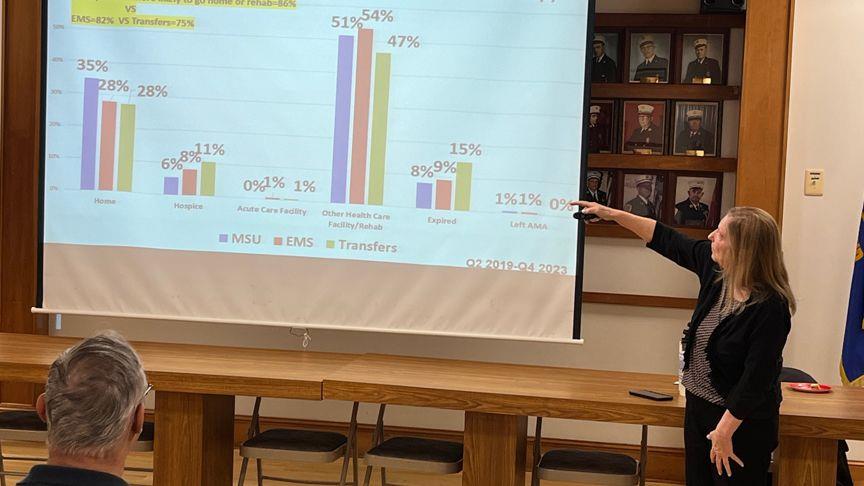The next time a 911 call comes through in Suffolk County, two emergency vehicles may respond: a volunteer community ambulance and a special Mobile Stroke Unit, which has proven to be a lifesaver as treatment can begin almost immediately for those suffering a stroke.
When it comes to strokes, time is critical as blockages can cause brain cells to deteriorate rapidly. “Minutes count,” said Eileen Conlon, a coordinator with Stony Brook’s Cardiovascular Center. “Rapid treatment in the Mobile Stroke Units saves precious brain cells and improves recovery.”
According to Conlon, who was the guest speaker at a recent meeting of the Pattersquash Creek Civic Association, strokes occur when blood clots, aneurysms, or other conditions cut off blood supply to the brain. Symptoms include sudden numbness or weakness in the face, arm, or leg; sudden confusion, trouble speaking, or difficulty understanding speech; sudden trouble seeing in one or both eyes; sudden trouble walking, dizziness, loss of balance, or lack of coordination; and sudden severe headache with no known cause. “If someone is experiencing any of these signs, let the emergency operator know, and the Stroke Unit will be dispatched,” Conlon said.
“They perform miracles,” said civic member Walt Meshenburg, who’s been a volunteer with the Mastic Beach Community Ambulance for 22 years. “What they do is unbelievable. It’s a great idea, and it works.”
Trained personnel can determine if the victim can go to the nearest hospital or if they should be sent directly to a comprehensive stroke treatment center such as Stony Brook. The two units operated by the cardiovascular center have CT scanners and angiogram equipment onboard and can send test results instantly to emergency room doctors, who can also appear on a screen in the ambulance to direct the emergency team.
“Too much time is wasted if a stroke victim is brought to a local hospital first and then has to be moved to a comprehensive center for the treatment they need,” Conlon noted. “Stroke patients have much better outcomes if they can get the right treatment as fast as possible.” According to the Registered Nurse, medications can be prescribed and administered while a stroke victim is in transport. This can avoid more invasive treatments such as medical procedures to remove stroke-inducing blot clots.
“Perhaps you’ve heard the expression, ‘Time is brain,’ said Dr. David Fiorell, director of the Stony Brook Cardiovascular Center. “It's a reminder that when you have a stroke and the brain cannot get the blood and oxygen it needs, brain cells die. To put this in perspective, it’s estimated that when a blood vessel supplying the brain is blocked, nearly two million brain cells are lost for each minute that passes, making stroke one of the most time-sensitive diagnoses in medicine. The faster blood flow can be restored to the brain, the more likely that a person will have a full recovery.”
Stony Brook has two units on 24-hour standby at Long Island Expressway exits 57 and 68 and their services are provided free of charge. “We find it much less expensive to treat patients quickly in the mobile units than to wait for more extensive treatment at the hospital,” Conlon said. Last year, the units were dispatched 7,078 times and were needed to transport a stroke victim on about one-third of the calls. A third unit is being planned for Riverhead.
“This was one of the most important presentations we’ve ever had. I wish it was standing room only," said Pattersquash Civic President Frank Fugarino. ”Learning the signs to watch out for when someone is having a stroke and being able to communicate to the dispatchers that the Stroke Unit may be needed will help us save lives.”
Conlon also went over risk factors for strokes and encouraged the civic members to watch what they eat and avoid excessive alcohol use and smoking. “High blood pressure and obesity are the greatest risk factors for a stroke,” she said, pointing out that 87% of strokes come from blood clots, many of which break off from plaque buildup in arteries. Aneurysms, which are bulges in blood vessels, can burst, causing strokes. “Don’t try to second guess the symptoms or self-diagnose,” she urged. “If you think something is wrong, call 911 immediately; tell them what you’re seeing. If it sounds like a stroke, the mobile unit will be dispatched.”
Conlon described the FAST System to determine if a person is having a stroke:
 |
|
RN Eileen Conlon with the Stony Brook Medicine Cardiovascular Center tells the
membership of the Pattersquash Civic Association about the Mobile Stroke Units. Stony Brook Medicine
|
A—Arms: Ask the person to raise both arms. Does one arm drift downward?
S—Speech: Ask the person to repeat a simple phrase. Is the speech slurred or strange?
T—Time: If you see any of these signs, call 9-1-1 right away.
